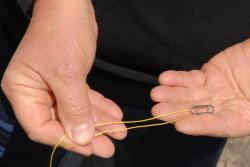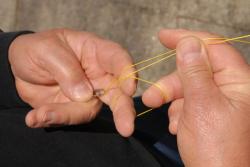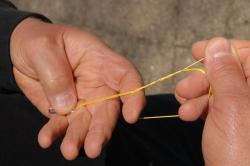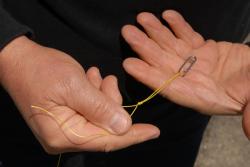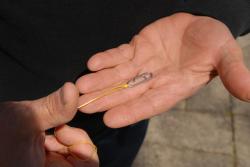Angling with Electronics: Five Techno-Tips for Fishing Success
Editor’s Note: Today’s feature comes to us courtesy of Traditions Media.
from The Fishing Wire
One of the real joys of fishing occurs when warm spring weather draws fish of all species into skinny water. Anglers don polarized sunglasses and scan the shallows for emerging signs of life. The “sight fishing” that results can be positively thrilling. It’s high-level sensory stuff that combines stalking, hunting and casting into a singular stimulating experience.
But before you know it, spring gives way to summer. Waters warm; the shallow bite shifts deeper. And if you’re not careful, you can quickly lose track of the fish you’d been catching earlier.
Summer and fall certainly yield terrific fishing, but they’re also the seasons during which great anglers often separate themselves from the pack. The difference usually resides in their ability to find fish. It’s a talent to be sure, and one that often begins with intuition. But the fact is, nearly every successful angler makes wise use of electronics; fish-finding sunglasses segue to sonar, GPS mapping, and underwater cameras. In a sense, each of these tools become our underwater eyes, solving mysteries and piercing the watery veil that otherwise separates us from big fish below.
Before you launch the boat this summer, consider these simple high-tech shortcuts to success.
#1 – Ditch the Paper Maps

Use Electronics
Armed with a simple sonar unit or an entire armada of fish-finding weaponry, it’s hard to discount the value of today’s technology. Photo by Bill Lindner Photography
We’ve all got ’em. Stored in the glovebox, stuffed into a bulging Ziploc bag; those old paper lake maps provide basic navigation and occasional fishing spot info. But try to unfurl one in the wind, or break one out in a downpour. Not good.
By now, most of us know about or have used a digital contour map displayed on a modern sonar/GPS unit. The advantages of a dynamic, interactive lakemap on your sonar screen is pretty profound. Products from LakeMaster (compatible with Humminbird sonar units) and Navionics (compatible with Humminbird and Lowrance) display lake, river and reservoir depth contours right on the screen, plus show your boat’s position as you move along and over various depths. When you catch a fish or see something that looks promising, you hit a button and drop an icon right on the map, so you can return and fish it anytime. You can even sit in your boat in the driveway, call up the map and drop waypoints on likely spots for later.
Most products also allow for specific depth shading and water level offsets. The latest mapping technology, called AutoChart, allows you to create your own 100-percent accurate depth maps of previously uncharted lakes, ponds, rivers or coastal areas. Simply turn on the unit, drive around the lake, and the map begins to magically take shape.
#2 – Spend an Afternoon “Just Looking”
If you haven’t yet experienced ultra-realistic side-looking sonar, such as Humminbird’s original “Side Imaging,” it may be time to upgrade the old electronics. This progressive sonar technology shoots its fish finding beams both left and right of the boat, showing you a photo-quality image of the real estate way up in the shallows, along drop-offs, under boat docks and more. While traditional 2-D sonar shows what’s below the boat, side-looking units can reveal fish that are off to the sides and unaware of your presence, making them prime targets for casting or trolling.
Want to discover those coveted hot spots that are unknown and untouched by other anglers? Spend a day on your favorite lake or river just cruising around and studying the side-looking sonar screen. When you mark an interesting object or location, simply drop a GPS waypoint on it. Boom, spot saved forever.
Scattered and hidden across the floors of most waterways lie a treasure trove of hidden fishing locations-scattered rockpiles, discarded Christmas trees, isolated clam beds, bridge foundations and old roadbeds. All of these can be angling goldmines, and side-looking sonar is an awesome tool for finding them.
#3 – Probe Cover with a Camera

Catch Big Fish With Electronics
The endgame of any high-tech approach: big fish in the boat. Photo by Bill Lindner Photography
So you’ve found that hidden heap of old Christmas trees, but how to know if anyone’s home? Sonar might show generic fish “arches.” But without knowing the species, size or position of the fish, you might use the wrong lure and fail to get bit. Worse, you could end up spending valuable time angling for carp that you thought were bass. It’s why some of the sharpest anglers today deploy an underwater camera, which shows you in real-time video exactly what’s happening below.
While sonar might display a beautiful brushpile, the camera reveals what’s living there. It shows that some brushpiles are void of fish life. But it also shows you the good ones, those that hold heavyweight largemouths, pods of crappies or big catfish. Armed with this all-important intel, you’re now ready to tie on the right lure or bait and experience some fantastic fishing.
Increasingly popular among anglers today are Aqua-Vu’s Micro systems. These self-contained underwater viewers sport tiny camera optics the size of an acorn, which easily slide into all those nooks and crannies in cover, and show you a real-life picture of every crappie, crawdad and clamshell in the vicinity. The LCD monitor is as small and compact as a smart phone, too, and the whole system stores easily inside a tackle box or even a coat pocket. If you’re not using a fishing cam, you’re could be missing out on some amazing and overlooked opportunities.
#4 – Deploy a New Wave Anchor
While this tip might not help you locate fish, it will certainly help you catch a few more once you do. Two new forms of boat control now allow you to hold the boat in a specific position without repeatedly heaving a 20-pound chunk of lead.
“Spot Lock,” a GPS driven function built in to several trolling motors, including Minn Kota’s Terrova, holds your boat continuously on an exact waypoint, simply by pushing a button on a remote control. Anytime the boat drifts 5 or more feet off course, the motor quickly propels you back to your position.
Performing a similar task in shallow water, hydraulic pole-style anchors drive a spike into the lake floor, by again, simply pushing a button. The Talon shallow water anchoring system from Minn Kota allows for automatic, effort-free anchoring in water from 2 to 12 feet deep. In wind, waves or for when you just want to stay put, these new wave anchor systems are almost priceless.
#5 – Sight Fishing On the Screen
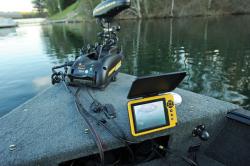
Underwater Camera
Modern underwater cameras provide unprecedented clarity and convenience, plus a nearly innate ability to find and identify fish.
If you’re a fan of sight fishing in shallow water, you’ll love the visual aspects of doing the same on a sonar screen. When fish such as bass, crappies, walleyes, stripers and catfish drop deeper or suspend, you can position your boat right above them, drop a lure and watch them react on screen. Not only is sonar sight fishing entertaining and exciting, it’s also a very effective way to catch fish.
Using Minn Kota’s Spot-Lock function or an anchor, position directly above fish in 15- to 30-or-more-feet of water. Next, tune your sonar unit so the transducer is using the narrowest beam (cone angle) possible. This can be done by switching from a wider beam to a narrower 18 or 12 degrees. Narrower beams provide more detailed information, and will allow you to watch your lure drop in the water column, as well as fish, as they swim over and bite.
On screen, your lure will read as a continuous solid line. When you jig, you’ll note immediate wavy lines corresponding to your movements. Tune the unit’s sensitivity so you can see your bait clearly, but without additional clutter on the screen.
When a fish approaches, try various jigging moves until you get a positive response. As fish get closer, they’ll appear as a darker, thicker signal. With practice, it’s often possible to detect a bite by watching the fish’s response on screen, even before you feel your line jump. Some compare it to a video game. But can a video game tug back, leap out of the lake or slap water in your face?
–Ted Pilgrim



